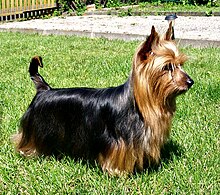
The Bichon Frisé or Bichon à Poil Frisé is a Franco-Belgian breed of small toy dog of bichon type. It was recognised by the Société Centrale Canine in 1933 and by the Fédération Cynologique Internationale in 1959.
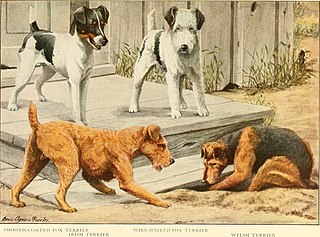
Terrier is a type of dog originally bred to hunt vermin. A terrier is a dog of any one of many breeds or landraces of the terrier type, which are typically small, wiry, game, and fearless. There are five different groups of terrier, with each group having different shapes and sizes.

The Affenpinscher is a German breed of small toy dog of Pinscher type. Originally developed as a mouser, the Affenpinscher is now commonly found as a companion worldwide.
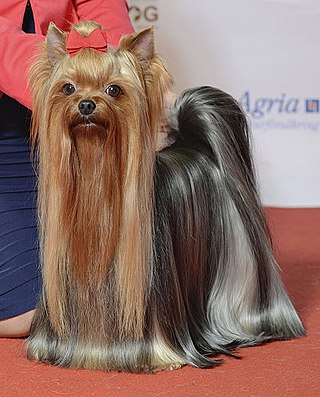
The Yorkshire Terrier, also known as a Yorkie, is a British breed of toy dog of terrier type. It is among the smallest of the terriers and indeed of all dog breeds, with a weight of no more than 3.2 kg (7 lb). It originated in the nineteenth century in the English county of Yorkshire, after which it is named. The coat is tan on the head and dark steel-grey on the body; no other colour is accepted by either The Kennel Club or the Fédération Cynologique Internationale.

The Miniature Schnauzer is a breed of small dog of the Schnauzer type that originated in Germany in the mid-to-late 19th century. Miniature Schnauzers may have been developed from the smallest specimens of the Standard Schnauzer, or crosses between the standard and one or more smaller breeds such as the Affenpinscher, Miniature Pinscher, and Poodles, as farmers bred a small dog that was an efficient ratting dog. They are described as "spunky" but aloof dogs, with good guarding tendencies without some guard dogs' predisposition to bite. Miniature Schnauzers are recognized in four colors internationally: solid black, black and silver, salt and pepper, and white.

The Australian Terrier is a small breed of dog of the terrier type. The breed was developed in Australia, although the ancestral types of dogs from which the breed descends were from Great Britain.
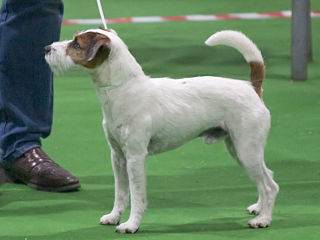
The Parson Russell Terrier is a breed of small white terrier that was the original Fox Terrier of the 18th century. The breed is named after the Reverend Jack Russell, credited with the creation of this type of dog. It is the recognised conformation show variety of the Jack Russell Terrier and was first recognised in 1990 in the United Kingdom as the Parson Jack Russell Terrier. In America, it was first recognised as the Jack Russell Terrier in 1997. The name was changed to its current form in 1999 in the UK and by 2008 all international kennel clubs recognised it under the new name.

The Toy Manchester Terrier is a breed of dog, categorized as a terrier. The breed was bred down in size in North America from the Manchester Terrier, and is placed in the Toy Group by the American Kennel Club and the Canadian Kennel Club. Neither the Fédération Cynologique Internationale nor The Kennel Club recognize a Toy variety of the Manchester Terrier.
Toy dog traditionally refers to a very small dog or a grouping of small and very small breeds of dog. A toy dog may be of any of various dog types. Types of dogs referred to as toy dogs may include spaniels, pinschers and terriers that have been bred down in size. Not all toy dogs are lap dogs.

The Lhasa Apso is a non-sporting dog breed originating in Tibet. Traditionally the breed has been used as an interior watchdog.

The Black Russian Terrier, also known as the Chornyi Terrier, is a breed of dog from the USSR. It was originally bred in the Red Star Kennel during the late 1940s and the early 1950s for use as a military/working dog. The Black Russian Terrier is a breed recognized by the FCI, AKC, CKC, KC, ANKC, NZKC and other cynological organizations. The contemporary Black Russian Terrier is a working dog, guarding dog, sporting and companion dog.

The Coton de Tuléar is a breed of small dog named for the city of Tuléar in Madagascar. This breed is thought to have originated from a group of small white dogs that swam across the Malagasy channel following a shipwreck. Known for its cotton-like coat, the Coton de Tuléar typically grows to no more than 18 pounds (8.2 kg), and are white, sometimes with grey, tan, black, or tri-colored markings. The Coton de Tuléar Day is celebrated on November 26.

The Lancashire Heeler is a small breed of dog developed for use as a drover and herder of cattle. The Lancashire Heeler is listed by the Kennel Club (UK) as an endangered breed. The breed was recognized by the American Kennel Club in 2024.
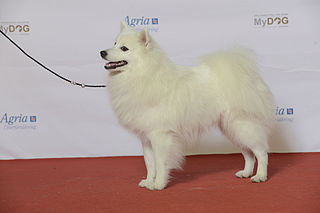
The Japanese Spitz is a small to medium breed of dog of the Spitz type. There are varying standards around the world as to the ideal size of the breed, but they are always larger than their smaller cousins, the Pomeranian. They were developed in Japan in the 1920s and 1930s by breeding a number of other Spitz type dog breeds together. They are recognized by the vast majority of the major kennel clubs, except the American Kennel Club due to it being of similar appearance to the white Pomeranian, American Eskimo Dog and Samoyed. While they are a relatively new breed, they are becoming widely popular due to their favorable temperament and other features.

The Andalusian Terrier or Sherry Terrier is a Spanish breed of dog of the terrier type. Its Spanish name reflects its main occupation: hunting rats and mice hidden between barrels in the wineries of Andalusia in Spain. It was recognised as an indigenous Spanish breed in 2000 by the Spanish Ministry of Agriculture and by the Spanish Kennel Club, the Real Sociedad Canina de España.
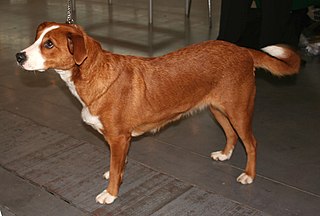
The Austrian Pinscher is a medium-sized breed of pinscher-type dog from Austria, where dogs of the type were originally farm dogs, keeping barns free of rats and acting as home guards, livestock guardians, and drovers. The name originally given to the breed in 1928 was the Österreichischer Kurzhaarpinscher to differentiate it from similarly named breeds, but today in its country of origin the breed is officially called the Österreichischer Pinscher, or Austrian Pinscher in English.

The Braques Français are hunting dogs, from a very old type of gun dog used for pointing the location of game birds for a hunter. There are two breeds of Braque Français, both from the south of France, the Braque français, type Gascogne and the Braque français, type Pyrénées They are popular hunting dogs in France, but are seldom seen elsewhere.

The Russian Toy is a very small breed of dog originally bred in Russia from the English Toy Terrier. There are two types of coats in the breed: smooth coat and long coat. The smooth-coated variety was previously known as the Russian Toy Terrier and long-coated as the Moscow Long-Haired Toy Terrier. Both were brought together under the same Russian Toy Terrier name in 1988 and the "Terrier" was dropped from the name when the breed was added in 2006 to the official list of breeds registered with the Fédération Cynologique Internationale. The breed has been registered in the Foundation Stock Service of the American Kennel Club (AKC) since 2008, and has been allowed to compete in AKC companion events since 2010. The first official breed standard of the two varieties was written in 1966 in Russia.

The Westphalian Dachsbracke is a small, short-legged scenthound, a breed of dog originating in Westphalia, a region of Germany. The Westphalian Dachsbracke was used in Sweden to develop the Drever.

The Paisley Terrier was a breed of terrier-type dog that is now extinct. Originating in Scotland, the Paisley Terrier was bred primarily as a pet and showdog version of the Skye Terrier, and was the progenitor of today's Yorkshire Terrier. The breed was called the Paisley Terrier since most of the dogs came from that location, but it was also called the Clydesdale Terrier, for another location in the Clyde Valley where the dogs were bred.
